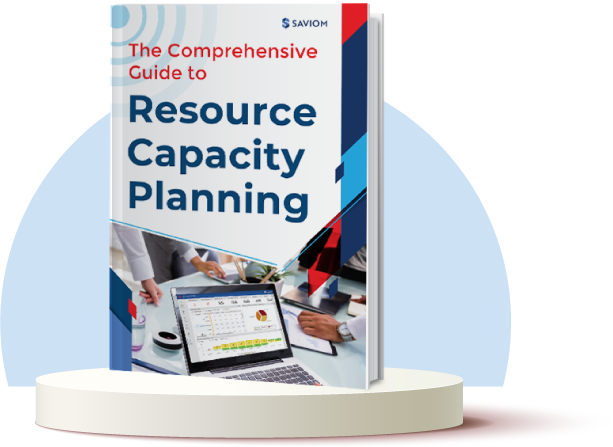Have you ever witnessed a project succeed without diligent resource planning? That’s a rhetorical question. Resource planning is at the core of successful project delivery and organizational efficiency. It ascertains that the right workforce with suitable expertise is allocated to the respective projects. Multinational corporations and growing businesses are investing substantially to streamline their resource planning process.
A study revealed that 53% of decision-makers consider enterprise resource planning an investment priority.
Like every other industry, engineering firms require a systematic resource planning process. Engineering projects demand niche skill sets and need heavy and expensive equipment during various stages of the project lifecycle. Resource managers and project managers strive from the beginning to identify the appropriate resources, understand their availability, and fulfill these demands.
If they fail to form a full-proof resource plan, they may encounter bottlenecks in the future, bringing the projects to a halt.
Thus, engineering resource planning is integral to successful project delivery within time and budget.
This article emphasizes the significance of resource planning in engineering projects and some strategic tips to get the process right.
Let’s get started,
What is resource planning in engineering projects, and why is it needed?
Supposedly, you are building an automobile with the help of automobile engineers, mechanical engineers, some heavy manufacturing equipment, and so on. When the project reaches a crucial stage, you realize you don’t have the equipment to proceed to the next step.
A challenge like this can catastrophically hamper the entire project’s progress, as acquiring new equipment at such short notice can easily blow up the budget. Moreover, since this falls in the project’s critical path, it will also adversely affect the billable utilization of other resources. However, had you foreseen the resource requirements and planned for them in advance, your project’s course would have continued seamlessly.
Engineering resource planning is a process of forecasting, allocating, and utilizing resources for engineering projects and operations.
When managers follow a definite system and equip modern, intuitive resource planning tools to fulfill the project demand even before the project initiates, it keeps these challenges at bay, leading to a successful outcome. In addition, resource planning helps control project financials and timelines and strengthens data-driven decision-making.

Since we have covered the significance of resource planning in project management, let’s learn about the types of resources required in engineering projects.
The required resources in engineering projects
Unlike other industries, projects that fall under the engineering domain require diverse skill sets and resources. Let us understand these requirements in detail:
Human resources
The employees are the most critical asset of any project. Their talent, skills, and capabilities allow the execution of assignments with the best quality and within the deadline. Engineering projects specifically require a wide array of personnel to work on different types of tasks. Here are some of the core competencies vital for an engineering firm:
-
Mechanical engineers
Projects encapsulating machine expertise or manufactured technologies need mechanical engineers.
-
Automobile engineers
As the name suggests, automobile engineers work in the automobile industry and work on vehicle design and production.
-
Electrical engineers
Any project with specific tasks pertaining to power system engineering, instrumentation, signal processing, etc., demands electrical engineers.
-
Software engineers
Software engineers are needed for tasks like web designing, software, app development, etc.
-
Analysts
With the advent of AI and Machine learning, the demand for analysts has escalated. Any engineering industry that requires the interpretation of data to make strategic decisions needs an analyst.
-
Construction workers
Engineering projects involve constructing, installing, and assembling several structures, systems, and components, so they need construction workers with the necessary skills to execute these tasks efficiently.
Equipment
Engineering projects require an array of equipment, machines, and tools to build a finished product. For example, heavy machinery is needed for the automobile manufacturing unit. These tools are expensive, and thus, some firms rent them from other companies and integrate these costs under project estimates. As a result, managers need to carefully plan the projects and determine the equipment required well in advance to prevent last-minute hiccups.
Materials
Materials are the building blocks of the final product and part of the finished goods. For example, construction materials like brick, cement, etc., are the necessary blocks to form the entire tower or database to develop a web application are the materials. Therefore, the onus is on managers to enlist every constituent required and accumulate them before the project’s onset.
Miscellaneous
Other than the above-mentioned primary resources, engineering projects require additional resources like:
- Organizational resources in terms of financials
- Contractors and vendors to procure the unavailable demand from external sources
- Extrinsic software for the overall management of projects
- Facilities like office space or warehouse, etc., to carry out the project tasks.
What are the key features of the engineering resource planning template?
Advanced resource planning software enables organizations to manage their workforce, minimize risks, and steer the engineering project to success. Listed below are some of the key features of resource planning systems in engineering projects:
Multi-dimensional resource planner
With the help of a resource planner, managers can effectively allocate resources like engineers, equipment, materials, etc., to different tasks and activities across the organization. Additionally, it will enable managers to identify and assign the best-fit resources to the projects.
It also helps track allocations across multiple dimensions such as team, department, location, etc. Furthermore, managers can capture the engineer’s time off and vacations, which helps better resource planning for current and future projects.
Forecasting and capacity planning
Forecasting and capacity planning enable managers to predict pipeline project demand and assess the gaps between resource capacity and demand. If any gaps are identified, the resource planner helps managers take corrective measures like training, hiring, adjusting project timelines, etc., ahead of time.
In addition, managers can foresee project vacancies and minimize the bench size by proactively assigning resources to suitable vacancies. Furthermore, forecasting helps managers track critical financial indicators like cost, revenue, and margins and take corrective measures to control project costs.
Resource utilization
The resource planning system enables firms to forecast the usage of engineering resources to optimize billable and strategic utilization. In addition, it allows managers to mobilize engineers and workers from non-billable tasks to billable and strategic ones.
Moreover, a resource planner helps identify and proactively mitigate under/over-utilization of resources. Moreover, real-time visibility into resource utilization will allow managers to optimize resource allocation, ensure even work distribution, and reduce risks associated with resource constraints.
Reporting and analytics
The resource planner offers real-time BI reports and analytics that provides insights into important engineering resource metrics like project performance, productivity, utilization, etc. The BI capabilities enable managers to generate customized reports, configurable dashboards, etc., which helps in data-driven decision-making.
Furthermore, it helps filter out information per the stakeholders’ requirements. In addition, it provides role-based access that helps to avoid information overload.
What-if-analysis & automation
The resource planning system helps managers to create and simulate various engineering project scenarios with what-if-analysis. It enables them to arrive at the best possible resource plan considering different resource-related parameters and then apply it to the actual schedule. Furthermore, the resource planning software streamlines the resource requesting process from requesting approval to allocating the resources.
These are some of the common features found in the template. Next, let’s learn about the various benefits of engineering resource planning.
What are the advantages of engineering resource planning?
For organizations to achieve their goals and ensure efficient usage of their engineering resources, it is vital to have an effective resource plan. Here are some of the critical benefits resource planning offers for engineering projects:
Minimizes engineering project resources expenses
Resource planning enables managers to allocate the right engineers and professionals to suitable projects that ensure the timely delivery of projects within the budget. In addition, it will control resource costs by eliminating the deployment of over/ under-skilled engineers.
In addition, resource planning helps identify potential conflicts between resource requirements in various engineering projects. Resolving these conflicts proactively can minimize the last-minute firefighting of resources, which can be expensive.
Improves planning and allocation of engineering resources
Resource planning facilitates the competent allocation of engineering professionals based on their skills, experience, qualification, cost, etc. Furthermore, firms can leverage cost-effective global resources and control project costs.
Assigning resources to tasks that align with their skills and expertise will enhance the quality of work, reduce the likelihood of errors, and expedite project completion. Resource planning involves a systematic approach to assessing the project requirements, resource availability, and skill sets that ensure the allocation of resources based on project priorities and objectives.
Better planning of pipeline project demand
With resource planning, managers can forecast and effectively plan pipeline project resource requirements. Furthermore, with capacity planning, they can identify shortages/ excess of the workforce and take proactive measures like training, hiring, adjusting project timelines, etc., to bridge the gap. This will eliminate the last-minute hiring activities that can cause cost escalation and compromise the quality.
Resource planning enables managers to evaluate resource skills, capacity, and availability. By assessing the availability of resources, organizations can plan and allocate resources effectively to meet the demands of pipeline projects without overloading or underutilizing them.
Enhances workforce utilization levels
With resource planning, managers can foresee the utilization of the engineers working within the project. This helps to effectively mobilize resources from non-billable to billable/strategic tasks, thereby increasing revenue. Furthermore, tracking and monitoring utilization levels helps eliminate over/ underutilization of engineering resources.
By considering the capacity and availability of each professional, resource planning ensures even distribution of workload, thus eliminating burnout and maximizing their utilization. Regularly tracking and monitoring the utilization levels helps address resource bottlenecks, reallocate resources as required, and make timely adjustments to enhance workforce utilization.
Enables successful project delivery
As the demand for resources in engineering projects is volatile, resource planning identifies and fulfills the requirements accordingly. Moreover, it helps maintain continuity by restricting resource movements within the projects. This ensures the timely delivery of projects within the stipulated budget.
Furthermore, by clearly forecasting resource needs, resource planning helps in the timely procuring and allocation of resources. This ensures that the project has the necessary workforce to move forward smoothly. In addition, efficient resource planning processes help identify potential resource risks and develop mitigation strategies. Addressing these risks ensures that the projects stay on track and meet their objectives.
Knowing the benefits of resource planning in engineering projects, let’s understand the techniques of engineering resource planning.
What are the steps of efficient engineering resource planning?
As mentioned above, resource planning in engineering projects goes beyond managing the workforce; it is a conglomerate of human and non-human resources. As a result, it escalates the complexities of the process, and managers must formulate a solid resource planning strategy.
Here are the steps you can follow to achieve the same:
Document the engineering project resource plan
Meticulous, detailed resource planning is the stepping stone to a successful project. The same applies to engineering projects. Even more so because it entails tasks from multiple dimensions and domains and has a diverse set of resource demands., therefore managers should first document a comprehensive project resource plan. This plan constitutes all the project phases (from initiation to execution), tasks under each phase, and the resource requirement (along with its cost and timeline) against each task.
Consider an example of an automobile project to build a hybrid drone. Its project resource plan will encompass the project tasks like forming a prototype that will include automobile and software engineers with hands-on experience in relevant software. The next task in the execution phase can be assembling the right parts, which is the job of mechanical and automobile engineers, and so on. Along with the workforce demand, equipment, materials, and other resources are also mentioned, including their quantity and timeline. Formulating these details in advance will provide an overview of resource requirements and other attributes, giving enough leeway to resource managers to fulfill the demand.
Find the right engineer for each project task
Now that the project demands are in place and in order, the next step is to find the right resource for the right task. Managers must note resources’ roles, skills, level of expertise, experience, location, cost, and so on while identifying them. This process is tedious when the resource profiles are logged in siloed spreadsheets. Thus, firms must invest in a sophisticated resource planning solution to filter their search and get a centralized view of enterprise-wide resources.
In engineering projects, dedicated engineering resource management software comes handy and is tailored to suit the same industry’s needs.
In addition to finding the right employee, managers must also find the right equipment and materials in the correct quantity in advance. It will give a clear picture of the deviation between the existing supply and demand and allow them to take adequate resourcing treatment in time.
Bridge the engineering skills gap in advance
One of the essential benefits of proactive resource planning is that managers get enough lead time to bridge the skills gap. It eliminates potential project bottlenecks and promotes seamless execution. The next critical step after identifying the resource pool is implementing suitable measures to align the resource supply and demand.
With the resource plan, we know building a drone requires mechanical and automobile engineers with core competencies in operating specific software, heavy equipment, etc. Suppose you have a shortage of 4 engineers and one piece of expensive equipment which cannot be bought due to budget constraints. With enough time in hand, you can hire the resources with niche skills or upskill the existing resource to reduce the project costs. To ensure that the equipment is available during project execution, you can find firms that have it and take it on a lease, keeping in mind the project budget.
Foresee the utilization and availability of equipment and workforce
It’s not always necessary that the resources you found from the internal channel are available to take up the job. They might be scheduled for a high-priority project or applied for a planned leave. It is, therefore, essential to foresee resource (human and non-human) availability and utilization. If critical resources aren’t available during the project timeline, you can take corrective measures to ensure the project position is filled.
Let’s say the engineer responsible for designing the prototype isn’t available or utilized to their total capacity. What would you do? One of the solutions is shadowing, in which a lesser-experienced resource learns from the required engineer. And once the learning is enough to keep the ongoing project on track, you can out-rotate the prototype without hampering the other project’s progress and backfill the position with the resource who shadowed them. Another solution is training the benched resources who have a similar background.
Allocate competent engineers with the right domain expertise to the tasks
After overcoming the resource constraints, it’s time to define the resource schedules. Referring to the project resource plan, managers can see each task’s timeline, and by keeping a buffer of 10%, they can book the resources accordingly. Some tasks that are not interdependent and can happen in parallel can be scheduled on the same timeline. In this case, one resource with appropriate competencies can be booked for multiple tasks eliminating the need to procure more employees.
However, if the tasks are interdependent, ascertain that the resource schedule is aligned with the next task to prevent future discrepancies. Similar to human resources, you should schedule the equipment and materials (or assets) after procuring them from vendors. To ensure that no one else books them during the same course, you can use an equipment scheduling solution to provide real-time visibility to the other managers and avoid conflict.
Implement the right optimization technique to balance the workload of critical engineers
Engineering projects are agile. Not every code or circuit works as planned. Maybe the circuitry you designed for the drone is disrupting the electronic speed controller from doing its job. So, one needs to revisit the prototype and make it more efficient. These processes are time-consuming and may overload the employees, posing a risk of burnout. However, most of the projects are time-sensitive, and delays can have a ripple effect causing the project to fail.
To ensure that it does not happen, managers can procure an additional resource to reduce the workload on one and still get the job done on time. It is known as resource smoothing, one way to optimize the resource schedule. When projects are not time-sensitive, managers can reduce the workload by extending the deadline. It is known as resource-leveling. These resource optimization techniques keep a tab on the resource health index and allow you to ensure that no resource is overutilized.
Given engineering projects’ ad hoc changes and agility, resource planning is always a continuous process. Let’s discuss how one can improve their resource planning strategy,
How can you improve your engineering resource planning process?
Often your estimates and actual attributes are misaligned. It means there is a need to improve the resource planning process. Either the forecasted values are inaccurate, or you haven’t gauged the criticality of the project tasks. To rectify these errors, you can adopt a modern resource planner. It provides robust, data-driven, accurate insights that allow you to plan with precision. You will get precise forecasts vs. actual reports for resource utilization, costs, etc., in real-time, which will give you enough time to do the damage control.
Moreover, you can form a ‘plan before the plan,’ i.e., simulate multiple scenarios by varying resource metrics to get the best-fit resource plan. It is known as the ‘what-if’ analysis. In addition, since experience is the best teacher, managers should learn from similar projects executed previously and note the mistakes made. Learning from history is the best way to improvise the future.
These simple steps and the right resource management tools will enhance the efficiency of the organization’s project resource planning process.
Here is the wrap-up with a small listicle of proven tips to get your engineering projects to the finish line,
Takeaway- Proven tips
- Deploy the right engineering resource management and equipment scheduling tool to suit your business needs.
- Form a work breakdown structure (WBS) or a project resource plan to list the resource requirement accurately.
- Allocate cost-effective global resources to keep the project costs in check.
- Consult multiple vendors before leasing equipment to get the best deal and control the financials before taking equipment on lease to get the best deal and control the financials.
- Review resources’ progress using the resource planning l and forecast vs. actual report…
- Take corrective actions ahead of time to prevent the cascading effect on the project’s progress.
- Implement the right optimization technique considering the project timeline and resource availability to avoid employee burnout.
- Resource planning is a work in progress. Revisit the resource plan regularly to get the possible outcome and maintain the resource health index.
Glossary
The SAVIOM Solution
SAVIOM is the market leader in providing an Enterprise Resource Capacity Planning solution. With over 20 years of experience leading the market, Saviom is actively used by over 15 highly esteemed global companies worldwide. The tools within the suite include project portfolio management, professional service automation, and workforce planning software. It also entails supporting solutions to schedule equipment and assets seamlessly. Re-engineer operational efficiency with a system shaped around your business!















